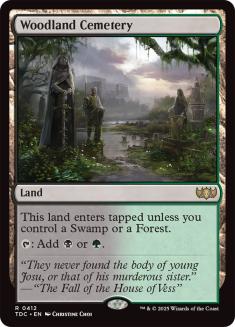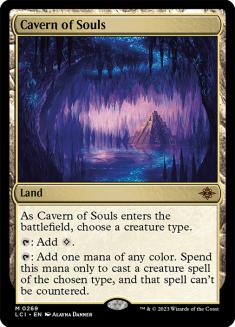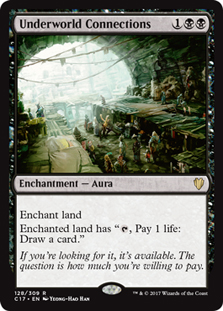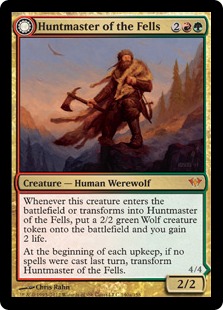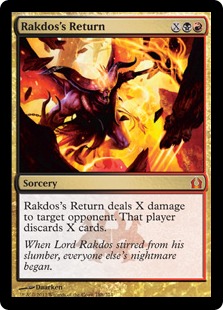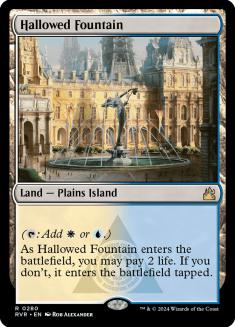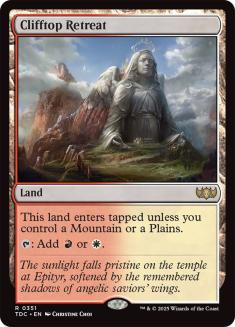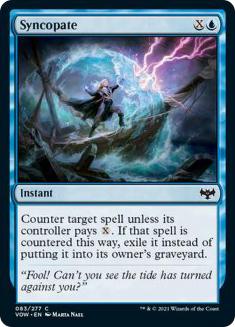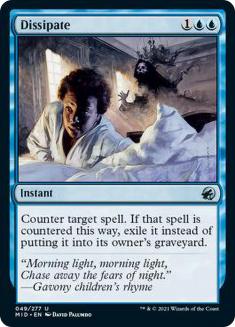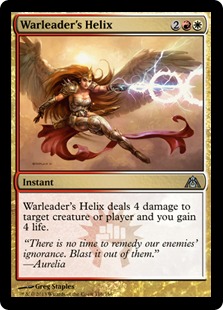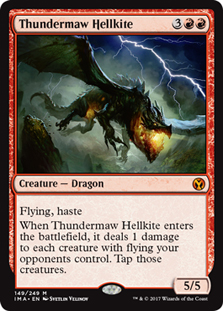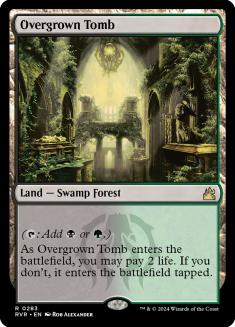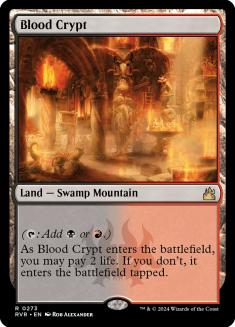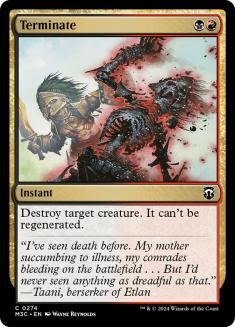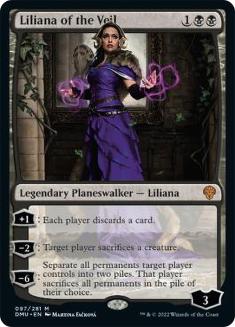Thoughtseize has come to be one of the most iconic cards in Magic. Though the card itself has not been legal in every format, the Thoughtseize effect is more or less ubiquitous in cards like Duress, Inquisition of Kozilek, and dozens of others. Now, with Thoughtseize being reprinted in Theros, its presence will be felt more than ever, and its status as a tournament staple is all but guaranteed for the next few years. Understanding how to use Thoughtseize will be integral to the success of any tournament player. Today I’ll cover everything you need to know about Thoughtseize, from deckbuilding to sideboarding to gameplay.
The Risks Of Thoughtseize
Trading One For One
The first step is to understand what Thoughtseize really accomplishes in a game of Magic. While it’s a hyperefficient card that sees extensive play even in Legacy and Vintage, there are some heavy costs associated with the card as well.
Thoughtseize, in terms of card advantage, represents a one-for-one trade—no advantage is gained directly. Therefore, step one in considering Thoughtseize is to think about whether your deck wants to trade one for one. Good candidates for Thoughtseize along this metric might be Jund or U/B Control. However, not every deck will fit this bill.
A common pitfall that I see among newer deckbuilders is a draw towards B/R decks that feature both a lot of burn and a lot of Thoughtseize effects. This is natural because black and red are a likely pair according to Magic’s flavor and those are among the most iconic effects that each color has to offer.
However, the reality is that Thoughtseize is exactly what a burn deck does not want. The strength of burn is that it’s difficult for the opponent to interact with through ordinary means, so if you add Thoughtseize to the deck in the place of a card that would otherwise contribute to your game plan, you’re really just giving your opponent exactly what they want—a way to trade off cards against you.
In my experience, such decks are excellent at getting the opponent down to five life but are not the best at actually winning games.
The same is true of ramp strategies, like Mythic and Wolf Run Ramp. These decks devote such a high proportion of their cards to mana that each nonland card must have a very high impact on the game in order for the strategy to work. So a card like Thoughtseize, the goal of which is to trade with an opposing spell (of which the opponent has many more than you), is not really what you’re looking for.
These decks can still consider Thoughtseize, especially as a sideboard card, for specific reasons that I’ll get into below, but it’s important to understand that its inclusion comes at a dear cost.
Redundancy
For decks that do want to trade one for one, Thoughtseize is appealing in its ability to accomplish that efficiently and reliably. However, it’s still not perfect for every situation. In terms of tempo, Thoughtseize does not affect the board and trades with a card which the opponent has not yet invested mana into—strictly speaking, casting a Thoughtseize puts you a little behind.
Consequently, Thoughtseize is quite poor against a deck with a lot of redundancy. Redundancy, in the context of a Magic deck, means that cards are very replaceable. Splinter Twin does not have much redundancy because it needs to assemble one copy of Deceiver Exarch, one copy of Splinter Twin, and one cheap way to protect the combo. Thoughtseize is excellent against such a deck because when you take away the opponent’s one Exarch, they have very few cards that they can draw that will help them recover from the loss and their deck functions poorly if they’re unable to do so.
The opposite example is a very basic creature deck—think White Weenie or Mono-Green Aggro. Thoughtseize would be at its worst against a deck of twenty Forests and forty Kalonian Tuskers because it’s overwhelmingly likely that you would take one Kalonian Tusker out of the opponent’s hand and they would simply play a different one instead. The Thoughtseize effect is doubly bad against such a deck because you cannot effectively attack their hand and casting Thoughtseize does not help you keep up with what’s on the board. You’d much prefer to have a Doom Blade, which answers a creature that the opponent has already spent mana on, or you’d prefer to have your own creature, which will help you under any circumstances.
Missing
What I haven’t yet mentioned is the chance of missing with your Thoughtseize, which is a huge risk that I consistently see players underestimate. Games of Magic are won and lost on small margins; when you mulligan, when you get two for oned, or when anything else happens to set you behind on cards, the pressure falls on you to do something great in order to pull yourself back to parity. If you cannot and both players have comparable draws, you will lose the game. I don’t think I’d be able to overstate how bad it is to miss on a Thoughtseize, particularly in Limited or in a grindy matchup like a Jund mirror. For you to want Thoughtseize in your deck, circumstances must be such that the risk of missing is very low or the rewards of hitting are very high.
The risk of missing is the main reason why the card Thoughtseize tends to outshine other versions of the Thoughtseize effect. It’s one of the reasons that I’ve never registered Appetite for Brains in a Constructed tournament, and it’s the reason why Duress is typically relegated to sideboard.
Coming Down To Topdecks
Let’s compare the Thoughtseize effect to the similar and equally iconic Counterspell effect.
The advantages of the Thoughtseize effect are:
- You can cast Thoughtseize at your own convenience, while Counterspell must be used in a specific window.
- You get to see the opponent’s hand.
- Thoughtseize and similar cards tend to be quite cheap.
- Some cards cannot be easily countered.
The advantages of the Counterspell effect are:
- You answer a card that the opponent has invested mana into.
- You protect yourself from topdecks.
You’ll come to regret the inclusion of Thoughtseize any time the game stalls out and players begin playing off the top of their libraries. Drawing Thoughtseize when the opponent has no cards in their hand (or only lands) is much the same as missing with it.
It’s an unfortunate quality of Thoughtseize that it helps draw the game towards that topdeck situation while also being an abysmal topdeck in itself.
Ask yourself during deck construction and during sideboarding how likely it is for the game to come down to a topdeck situation; indeed, sometimes it’s your goal for the game to get to this point (Jund, Junk, Pox, and similar decks frequently have this goal). If it seems likely, then ask yourself how much you can afford to dilute your deck with cards that are so bad to draw in the lategame.
A simple way to weigh the risks and rewards of Thoughtseize is to consider it a card that’s excellent to have in your opening hand and poor to draw at any other time. Before you start playing, try to predict how many turns the game is likely go, and you’ll get a number for how many cards you’re going to see in a typical game. Compare the number of cards that you’ll draw in your opening hand (hopefully seven) to the number of cards you’ll draw off the top of your deck in the course of the game.
When this ratio is high, as it is against a fast combo deck, Thoughtseize is more likely to shine. While it might not be intuitive, I’ve found Inquisition of Kozilek to be an excellent card in Modern Jund against decks like Affinity and Burn (the life loss on Thoughtseize can be a large cost and should be evaluated on a case-by-case basis) for exactly this reason. When the ratio is low, as it is in something like a Jund mirror, Thoughtseize is more likely to be a liability.
For years, I’ve felt confident in my ability to win Jund mirrors in Modern. My secret is that I sideboard out every last Thoughtseize, Inquisition of Kozilek, and Duress that I have in favor of cards that are more powerful to rip off the top of my deck. Almost invariably both players have empty hands by turn 4 or 5, and against an opponent who has six dead draws in their deck, my chances to win a game from that point become quite high the longer the game drags on.
To recap, be wary of including Thoughtseize in decks that do not want to trade one for one. Thoughtseize has lower value in a metagame full of decks with a lot of redundancy. Look to sideboard out Thoughtseize against decks like this and in matchups that are likely to come down to topdecks.
I recommend restricting yourself to five or six copies of Thoughtseize effects in your maindeck and seven between maindeck and sideboard. This is my personal maximum that I adhere to in every format.
The Rewards Of Thoughtseize
Now that I’ve warned you about the dangers of overloading your deck with Thoughtseize and its cousins, I’m free to explain why despite these weaknesses it stands as one of the most useful tools available to a deckbuilder.
Breaking Up Synergy
My philosophy in deckbuilding is to focus on cards that are individually powerful by their own merits. However, this is not the only way to build Magic decks. In fact, my friend and teammate, the esteemed Sam Black, takes much the opposite approach, looking for advantages in favorable interactions between cards. Such an approach has many benefits. Even my Tarmogoyfs will look foolish when they face down Sam’s Bonescythe Sliver, Megantic Sliver, Syphon Sliver, and Galerider Sliver all in play at once! (I insult Sam’s creativity only in the interest of a simple example).
It’s cards like Thoughtseize that allow the well-rounded, Rock-style strategies to compete against the (typically) more powerful synergy-based decks. Thoughtseize represents a way to trade resources quickly and efficiently, and once you can force that Galerider Sliver to stand on its own, your more powerful cards will win their individual battles. The Thoughtseize effect accomplishes the goal of breaking up synergy better than more situational answers like Doom Blade or Naturalize because of its applicability against creature-based strategies, control, and combo alike.
Answering A Specific Problem
What’s the first thing you do when you lose game 1 of your Limited match to Primeval Bounty? Presumably, your answer is something along the lines of “feel sorry for myself” or “mutter curses under my breath.” If so, what’s the second thing you do? Personally, I scour my sideboard for Naturalize, Solemn Offering, Bramblecrush, or any other method I can find in desperation to get an enchantment off the table!
But sometimes you’re playing a B/R deck.
Well, the Thoughtseize effect is a great way to answer a problem card that you can’t otherwise handle. Before I broke down and added Golgari Charm to the sideboard of my Standard Jund deck, I was sideboarding Duress in against Mono-Red Aggro with the goal of stripping away a Burning Earth and trying to win the game before my opponent topdecked another. It’s not the perfect plan, but it’s better than simply giving up!
Plus, some cards simply cannot be answered after the fact. Imagine a B/W Tokens deck that struggles a great deal against Supreme Verdict. The best answer might be to try to take it away with Thoughtseize!
I always rest a little easier when I have Thoughtseize in my deck because I know that it represents at least a possible answer to nearly anything my opponent can throw at me. I’ll return to the concept of “answering a specific problem” in the gameplay section below.
Seeing The Opponent’s Hand
While it’s hard to put a tangible value on seeing the opponent’s hand, I’ve always found it to be quite a large advantage that most players undervalue.
Personally, I was a player who developed good and precise technical play before I had much of a knack for reading my opponents. Perhaps it was due to my background in Magic Online or maybe just related to my introverted personality, but either way when Gitaxian Probe was first printed, I added it to all of my decks and began to win a lot more.
I played Gitaxian Probe in decks that you wouldn’t think could make particularly good use of it: U/B Control, Caw-Blade, etc. However, I found it easy to find a route to victory once all hidden information was laid out before me.
The effect of seeing the opponent’s hand is very powerful and can be life or death in certain matchups. Just as one example, consider the difference between a Storm player who casts Duress, sees the coast is clear, and takes their easy win versus one who sees a hand full of counters and knows to be patient and wait for more disruption.
Creating A Hole
The real key to Thoughtseize follows from the ability to see the opponent’s hand and is what sets it apart from similar effects like Hymn to Tourach, Cabal Therapy, and Counterspell. You see your opponent’s hand, you consider the game, and then you decide what card to choose.
Let’s return to the topic of redundancy. I offered the all Kalonian Tusker deck as an example of a deck with so much redundancy that Thoughtseize becomes a liability. However, the real-life equivalent of such a deck can sometimes be surprisingly vulnerable to Thoughtseize. Even if we restrict ourselves to Mono-Green Aggro, decks will still play their creatures on a mana curve starting at one and reaching up to four, five, or six. They might have combat tricks or finisher cards like Overrun; they might have utility cards or planeswalkers. When you cast Thoughtseize, you can see what resource or category of card the opponent is short on and attack that.
If you see a hand of weenie creatures, you can strip the one Giant Growth and feel safe behind your Sengir Vampire. If you see a hand full of top-end finishers, you can strip their one cheap play and push your early advantage.
I made the claim earlier that Thoughtseize puts you behind on tempo, but this is truer in a technical sense than in practice since you can use Thoughtseize to break up an opponent’s mana curve. If you cast it early in the game and they only have one strong play to make on the following turn (or if you can plan further ahead than that), you can strip that card and make them waste their mana.
Gameplay: Casting Thoughtseize
Creating A Hole Against A Control Deck
With regard to redundancy, we’ve discussed creature beatdown decks, and we’ve discussed synergistic combo decks. A third category of deck against which Thoughtseize really shines is the reactive control deck.
While control decks often feature cards that are individually good, they do require a proper mix in order to function properly. For example, not enough creature defense and you can lose to a quick rush. No counterspells and you can lose to a planeswalker; no finishers and you can flood out and lose the late game. These are the matchups where creating a hole is most important.
I believe that Thoughtseize has become even better against control decks as the card pool of Magic has expanded, and is particularly powerful alongside planeswalkers. I love playing Jund against control decks like U/W/R in both Standard and Modern because there are so many possible approaches to the game and it’s a fun challenge to find the best one.
Standard Jund (after sideboarding) will have powerful creatures, planeswalkers, Rakdos’s Return, Underworld Connections, and sometimes even more angles of attack like Acidic Slime or Ruric Thar, the Unbowed! Granted, U/W/R has ways to beat any and all of these cards, but it’s difficult for the opponent to have them all at any one time. It’s nearly impossible when you’re Duressing them.
When you cast Duress, you get to see your opponent’s vulnerabilities. If they have too much removal, then maybe you shouldn’t even bother trying to beat them with creatures—just take away their counter and resolve a Rakdos’s Return. On the other hand, if you Duress on turn 1 on the play and they have a hand full of Dissipates, take away their Detention Sphere and see what you can stick in the first three turns of the game.
Example: You have two lands in play, and your opponent has one. You cast Duress on turn 2, and these are both players’ hands.
Your hand:
Opponent’s hand:
Generally speaking, Underworld Connections is one of the best cards against U/W/R, but the key to this situation is that you need to ignore it, at least for the time being. This Duress has shown you your opponent’s strength—a lot of counterspells—and one possible weakness—not many answers to a resolved creature. In this example, I would take Warleader’s Helix and use Cavern of Souls to resolve Huntmaster of the Fells.
Huntmaster is not traditionally one of the best cards in the matchup, but in this case it’s what the situation calls for. The opponent has plenty of topdecks that can answer the Huntmaster, but at least if they have to tap out for Supreme Verdict or Thundermaw Hellkite, you’ll have a window to resolve a spell in spite of all their counters. You’re unlikely to have much luck trying to brute force through all of those counters.
Answering A Specific Problem
The gameplay of Thoughtseize comes down to two questions—when to cast it and what card to take. The two questions are related.
Once you know the matchup, ask yourself what the most important cards are to take with your Thoughtseize. In the example of the Limited match used above, I’ve sideboarded in Duress with the goal of stopping my opponent’s Primeval Bounty; the ideal time to cast Duress is probably the turn right before they hit six mana since that’s the time that they’re most likely to have the Bounty in their hand.
If I’m playing Jund and my opponent is playing B/W Tokens with the troublesome Auriok Champion, then I’m going to make sure that I cast Thoughtseize on turn 1 when I’m on the draw and by turn 2 when I’m on the play.
I could go on and on with examples of proactive problem cards that your opponent could have, but the answer is typically going to be to cast Thoughtseize as late as you can conveniently do so without giving them a chance to cast the problem card. It’s important to note that in reality there are frequently multiple problem cards in any given matchup, in which case you need to adjust accordingly. Say the Primeval Bounty player is G/W and also has Ajani, Caller of the Pride; it would be foolish to wait too long on your Duress and let them stick the planeswalker because then you might lose a game where they don’t even draw Primeval Bounty!
The more interesting situation is when you’re dealing with reactive problem cards. Remember the Wolf Run Ramp deck from earlier, which doesn’t love the idea of playing with Thoughtseize because it doesn’t want to trade one for one? Well, this might be a deck that simply has a really hard time beating Dissipate, and needs to sideboard Thoughtseize with the primary goal of stripping a Dissipate and resolving a Primeval Titan.
In this case, you want to be as patient as possible with your Thoughtseize, waiting until the turn before or the turn you’re ready to cast your Titan. It would be awful to fire off your Thoughtseize on turn 1 and then have them draw into Dissipate in the meantime. The trickier situations will arise on turn 5 when you don’t have a Titan in your hand but are hoping to draw one or when you have Titan, Thoughtseize, and six mana but no seventh land in hand. These should be handled case by case depending on how desperate you feel and how much you can afford to be patient.
If I’m forced to make generalizations, I would try to hold my Thoughtseize in the first example until I draw a Titan. I would cast Thoughtseize right away in the second example so that I can play Titan the following turn whether I draw a land or not.
Notice that in all of the examples given so far the only time Thoughtseize has been cast on turn 1 is when we’re on the draw against a deck with Auriok Champion. Thoughtseize does not have to be cast at the earliest possible moment unless there is a special reason why you want to play it that way.
I’ll close today by making some general suggestions about how to use Thoughtseize when you do not have a specific goal in mind.
Thoughtseize For Value: When To Cast Thoughtseize
Do not let Thoughtseize ruin your own game plan. Thoughtseize should simply be one more tool to use at your convenience and not a card that should force you to go out of your way. Unless I have a reason to do otherwise, I will play my creature instead of playing my Thoughtseize. Unless I have a reason to do otherwise, I will play my tapped land instead of playing my Thoughtseize. I do not know whether Thoughtseize will go up or down in value each additional turn I wait, so I will make plays that I know are time sensitive (playing creatures) first and will not pay a tangible cost (two life on a shockland) in order to play the Thoughtseize sooner.
Example: You’re playing Modern Jund. This is your hand on the play against an unknown opponent:
In this scenario, I would play Blood Crypt tapped. If my opponent did nothing, I would play Thoughtseize on turn 2 and play Overgrown Tomb tapped. There is no predictable play that my opponent could make on turn 1 that I feel I desperately need to stop. If they play Deathrite Shaman, I can Bolt it and Thoughtseize on turn 2. If they Thoughtseize me, my hand is fairly redundant, and I’m not afraid of losing any particular card. If they cast Serum Visions or hold up Spell Snare, I don’t really care; I probably wouldn’t have taken those cards anyway.
If I were to topdeck a two-drop creature, my patience will have cost me a little bit, but Jund isn’t a deck where you really need to rush. Life is important, and it’s not even clear that “shock myself, Thoughtseize, shock myself, Dark Confidant” will be a great play depending on the matchup. I stand to gain two life and have extra information by paying the small price of waiting one extra turn on my Thoughtseize.
Thoughtseize For Value: What Card to Take
A convenient time for casting Thoughtseize has finally presented itself, but you still have no special goal in mind. First, look at the opponent’s hand and see if you can create a hole, aka create and exploit a vulnerability. If you can’t, no problem. There’s no need to try to force anything or to get impatient—just take their most powerful card!
In Modern, I have a hierarchy of cards that I like to Thoughtseize away against blue midrange or control decks. When in doubt, I take Snapcaster Mage. If there’s no Snapcaster Mage, I take Cryptic Command, and if there’s no Cryptic Command, I take Sphinx’s Revelation or some other powerful late-game card.
I also have a rule that I never try to mana screw my opponent; lots of experience has simply led me to view it as an unreliable strategy. I never take a Mox Opal or Springleaf Drum against Affinity ever. If my opponent kept a one-lander with Serum Visions, I’ll often still take their Snapcaster Mage unless I really think I can put on a lot of pressure and close the game fast. Eventually, your opponent will draw out of their mana screw, and you’ll regret not taking their more powerful card. If they don’t, then you’ll win anyway.
Putting It All Together
I hope this primer has helped you to better understand Thoughtseize, if only in a small way. The card is an incredibly powerful tool that all tournament Magic players should know how and when to use. However, it carries a substantial amount of risk with it as well.
To recap:
- Thoughtseize doesn’t belong in just any deck.
- Sideboard it out against decks with redundancy or when the game is likely to come down to topdecks.
- Think ahead about what cards you most want to take with Thoughtseize. Use it to answer the cards that you can’t easily answer otherwise.
- When you cast Thoughtseize, try to create a hole. Look for a vulnerability and push that angle of attack
- When in doubt, get maximum value from your Thoughtseize by casting it at your convenience and taking the opponent’s most powerful card.
Keep these tips in mind and Thoughtseize will serve you well across many formats and for many years to come.


